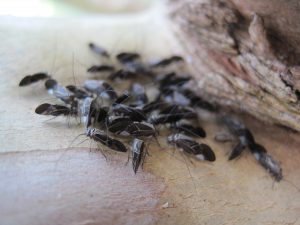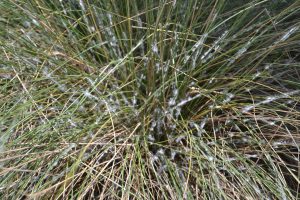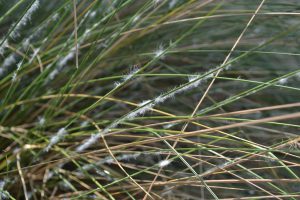by Matt Lollar | Jun 27, 2016
Cattle aren’t really grazing on the trees (this time), but tree cattle (a.k.a. bark lice) are grazing on the trees. The scientific name for tree cattle is Cerastipsocus venosus. Adults have shiny black wings that are held at a sharp angle resembling an old style camping tent or an F-117 Nighthalk stealth fighter. Wingless adults also exist.
The nymphs have an ovate abdomen with dark gray and light yellow banding similar to a honeybee. A related species, Archipsocus nomas, is known to produce unharmful webbing that covers the trunk and branches of trees, but not the leaves.

Tree cattle herd on a crape myrtle. Photo Credit: UF/IFAS Extension.

An F-117 Nighthawk. Photo Credit: Staff Sgt. Jason Colbert, U.S. Air Force.
These insects are usually seen in a colony containing a mixture of nymphs and adults. Unlike hair lice, bark lice are not parasites and are classified as beneficial insects. Unlike most beneficial insects, they do not feed on other insects. Instead, they clean the bark by eating excess accumulations of fungi, algae, lichens, dead bark, and other nonliving material. Tree cattle are not bark borers and do not eat leaves or living bark.
They are often seen on crape myrtles, but have been reported to graze on oaks and Bradford pears. Bark lice are more prevalent during hot and humid summer months.
Tree cattle are classified as beneficial, therefore no management is required. Because clientele may consider the term beneficial insect to be an oxymoron, it is important to supply supplemental educational materials to back up your claim. Publications are available from Clemson University and Auburn University.
by Beth Bolles | Apr 22, 2016
Muhly grass (Muhlenbergia capillaris) is a generally pest free plant in our area, however, we are seeing the native mealybug, Stemmatomerinx acircula, on plants in various landscapes. Insects are on the leaves and are grey with white wax that may have some filaments. You may also see long ovisacs on the leaves which contain eggs and crawlers. The native fakahatchee grass may also be a host.

Muhly grass infested with mealybug. Photo: Beth Bolles

The mealybug is white with fine filaments and numerous mealybugs can be found each leaf. Photo: Beth Bolles
The common practice of right plant, right place does not always prevent the mealybug infestations on muhly grass. Specimens in both full and shade can be affected, as well as mass plantings and those spaced out. At this time, there is not a lot of information on why some plantings are heavily infested and others are not.
Since mealybugs are piercing sucking insects, there may be some browning of leaves, especially on less vigorous plants. You may have to remove and destroy plants that are heavily infested and declining. In situations where treatment is warranted you may choose a systemic insecticide or oil spray to keep plants looking more attractive. As the landscape manager, you will need to decide what is an acceptable threshold for this pest.



